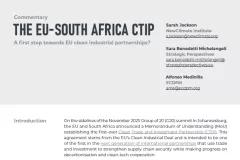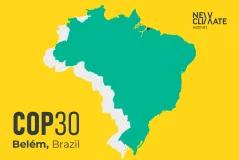Q&A with Thomas Day and Reena Skribbe from NewClimate Institute – 14 September 2023
Apple announced its first carbon neutral products on 12th September, 2023. This memo contains a Q&A reaction with the authors of the Corporate Climate Responsibility Monitor (CCRM), on the meaning of Apple’s new announcement and the extent to which this represents any significant development of the company’s climate strategy.
What were the findings of the CCRM, pertaining to Apple’s climate strategy?
Apple is one of very few companies assessed in the Corporate Climate Responsibility Monitor (CCRM, published February 2023) to have set and be implementing reasonably ambitious medium-term emission reduction targets. However, we found that Apple’s carbon neutrality claims create an unnecessarily misleading exaggeration of the company’s ambition. Without the misleading marketing, Apple could stand out as a role model for several aspects of its climate plan, but there remain also significant areas of potential improvement.
What does it mean that Apple’s new watches are “carbon neutral”?
On 12th September 2023 Apple unveiled a new range of watches which it claimed to be its first carbon neutral products. Apple describes some promising measures it has taken to reduce the emission footprint of these products, including the partial use of recycled materials and a moderate reduction in emissions-intensive air transportation. This is a good step, but it is a bold exaggeration to imply that these products have a neutral impact on the climate. Apple has used carbon credit certificates of claim to have offset significant portion of its emissions, using carbon credits from forestry projects and other carbon dioxide removals, although such certificates are not in any way equivalent to the reduction of the remaining emissions. Apple’s assertion that the electricity for manufacturing and product use is 100% clean is also highly contentious, since Apple’s major suppliers continue to have very low renewable electricity shares, and Apple does not have the means to ensure that its customers use the products with renewable energy.
How does this relate to Apple’s carbon neutrality target for 2030?
This announcement is aligned with Apple’s existing pledge for all of its products to be carbon neutral across the full value chain by 2030. This pledge is subject to the same limitations as Apple’s carbon neutral watches, in that Apple only plans to reduce its full value chain emissions by 63% compared to 2019 levels, while offsetting the remainder. Although a 63% emission reduction by 2030 represents a steep decarbonisation pathway, it does not represent the degree of decarbonisation that the ‘carbon neutral’ terminology implies. It is also unclear to what extent this partial emission reduction target depends on contentious accounting methods for renewable electricity in the supply chain, which may further undermine the real depth of this target.
Apple’s newly announced pledge to reduce its emissions by 90% by 2050 is a far more transparent representation of Apple’s ambition and prospects than a carbon neutrality pledge for 2030. The announcement of this pledge could mark a significant improvement in the company’s long-term strategy, since the company had previously not clearly committed to any further action beyond its 2030 emission reduction pledge.
Why are carbon neutrality claims based on natural carbon dioxide removals inaccurate and misleading?
Carbon credits cannot be considered an equivalent alternative to the reduction of companies’ own emissions. The quality of available carbon credits is highly contentious. The environmental integrity of carbon credits is afflicted by various factors, including but not limited to the contentious additionality of carbon crediting projects, the limited permanence of carbon stored from carbon dioxide removal projects, and the risk of double counting for emission reduction impacts. Recent scientific literature has demonstrated again and again that the real impacts associated with carbon crediting projects is far inferior to what their labels suggest, and at times negligible (West et al., 2020, 2023; Guizar‐Coutiño et al., 2022). Ever more companies and carbon crediting intermediaries are moving away from offsetting claims[1], recognising that they cannot be robustly defended.
Apple recognise these issues when they state that they procure credits only from “high-quality” projects which they define as “those from projects that are real, additional, measurable, and quantified, with systems in place to avoid double-counting, and that ensure permanence” (Apple, 2023). But the forestry and land-use carbon dioxide removal projects that Apple pursues simply cannot fulfil such criteria, due to fundamental issues which make such projects especially inappropriate for emission neutralisation claims. Due to natural or human-induced disturbances such as forest fires, land degradation or land-use change, carbon storage in forestry and land-use projects is likely to only be temporary, and therefore in no way comparable with not having emitted GHGs in the first place. Aside from this fundamental and irresolvable issue, the 2023 CCRM found that the offsetting plans of major companies wildly exceed our planetary boundaries, being so dependent on forestry and land-use projects that they would require at least four planet’s worth of natural resources to be realised. For these reasons, the use of certificates from such projects is simply not a feasible solution for truly neutralising emissions.
Does Apple really need to be exaggerating its climate ambition? What implications may this have for the tech industry?
Apple could stand out as a role model for various aspects of its climate strategy without the exaggerating claims that let it down. Apple’s GHG emission reduction targets are relatively strong, it has one of the highest quality strategies in the industry for the procurement of renewable electricity for its own operations, and we see that the company is taken meaningful measures to extend the lifetime of its products. These measures are a good step towards reducing emissions in an electricity-hungry and consumption-heavy industry, but it is an inaccurate exaggeration to imply that the company’s products are anywhere close to having reached the point of having no climate footprint.
Apple’s announcement could potentially have negative implications for transparent communication of companies progress towards climate targets in the tech industry, where we already perceive a race to the bottom for leading competitors such as Apple, Microsoft and Google to keep up with each others’ exaggerated marketing claims (see Spotlight 4.3.3 Is the tech industry really carbon neutral? in the 2023 CCRM).
How could Apple really reduce the life-cycle emissions of its products?
Apple’s Supplier Clean Energy Programme is a good start to addressing renewable electricity in the supply chain, which is a significant source of emissions. The programme represents a complementary package of measures for supplier engagement that could significantly reduce supply chain emissions, if implemented with conviction. But it is not yet clear to what extent the Supplier Clean Energy Programme has the depth and conviction to significantly decarbonise the supply chain by 2030. Progress to-date remains very limited for some of Apple’s major suppliers such as Hon Hai and Pegatron, which report renewable electricity shares of just 8% in 2022 and 6% in 2021, respectively (Pegatron, 2022; Hon Hai, 2023). Some other major suppliers are heavily reliant on Renewable Energy Certificates (RECs) for their reported renewable electricity shares, although RECs – like carbon credits – are unlikely to have any meaningful impact on really reducing emissions. This programme of support measures could be significantly strengthened if Apple were to exert its influence to place stronger demands on its major suppliers to achieve significant renewable electricity shares.
Moreover, targeting only Apple’s share of production limits the impact that the supply chain target may have on additional renewable capacity and real emission reductions. The company’s 2030 target only covers electricity from Apple’s share of suppliers’ production. This may significantly limit the impact of Apple’s renewable electricity target for suppliers, since suppliers may reallocate the renewable portion of their electricity between contractors, and Apple could claim the renewable share and shift the emissions intensity to other contractors. In some cases, for suppliers where Apple accounts for a minority of their output, the achievement of these targets may require only very shallow rates of renewable electricity consumption and may not require significant additional action. The supply chain target would be considerably stronger if Apple would aim for its suppliers to be operating on 100% renewable energy, rather than just allocating the renewable part of its electricity mix to Apple output.
Beyond renewable electricity, the elimination of full life cycle GHG emissions is a highly complex issue for any product, due to the large number of emission sources, the fragmentation of supply chains, the lack of control over user behaviour and the emission-intensive nature of our existing society. Instead of papering over the cracks of these realities, it would be more constructive to be transparent about really occurring GHG emissions throughout the life cycle, and the fact that there are significant challenges to address these immediately or in the short-term. This transparency is necessary to raise awareness to consumers that their consumption and use does have a significant climate footprint, and to foster constructive dialogue on how to collectively address the barriers to remaining emission sources that cannot be addressed by the company alone.
[1] Carbon consultancies like my climate and South Pole recently abandoned their "climate neutral" labels while Klarna, Gold Standard, easyJet and DSM have distanced themselves from offsetting in the past year.
References:
Guizar‐Coutiño, A. et al. (2022) ‘A global evaluation of the effectiveness of voluntary REDD+ projects at reducing deforestation and degradation in the moist tropics’, Conservation Biology, 36(6). Available at: https://doi.org/10.1111/cobi.13970.
Hon Hai (2023) 2022 Sustainability Report. Available at: https://www.honhai.com/s3/reports/CSR/EN/2022/鴻海-2022ESG(EN)-20230731-all.pdf.
Pegatron (2022) 2021 Pegatron Sustainability Report. Available at: https://cht.pegatroncorp.com/files/backend/csr_file/2021年永續報告書_英文版_0922.PDF.
West, T.A.P. et al. (2020) ‘Overstated carbon emission reductions from voluntary REDD+ projects in the Brazilian Amazon’, Proceedings of the National Academy of Sciences, 117(39), pp. 24188–24194. Available at: https://doi.org/10.1073/pnas.2004334117.
West, T.A.P. et al. (2023) ‘Action needed to make carbon offsets from forest conservation work for climate change mitigation’, Science, 381(6660), pp. 873–877. Available at: https://doi.org/10.1126/science.ade3535.






